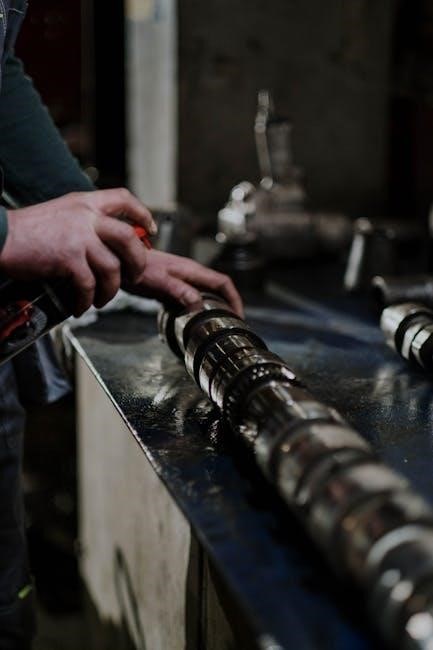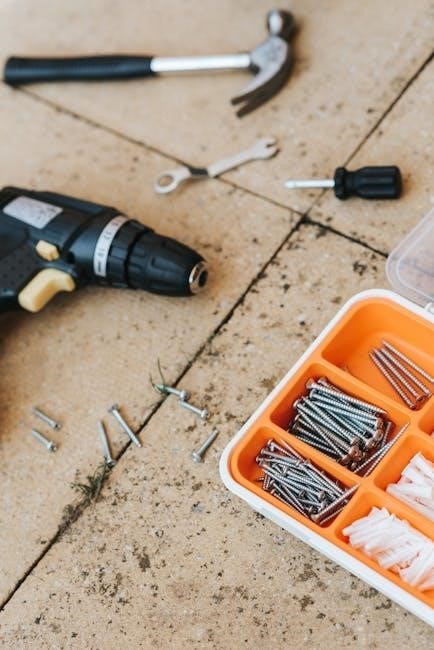The Tecumseh Engines Manual is a comprehensive guide for understanding, maintaining, and repairing Tecumseh engines. It covers 2-cycle, 4-cycle, and cast iron models, providing essential troubleshooting and maintenance tips for optimal performance and longevity. Refer to this manual for detailed instructions and specifications to ensure your engine runs efficiently and safely.
1.1 Overview of Tecumseh Engines
Tecumseh engines are renowned for their reliability and performance in small equipment applications. Available in 2-cycle, 4-cycle, cast iron, and horizontal crankshaft configurations, they power lawn mowers, snow blowers, and similar devices. Known for durability, they feature robust designs suited for varying workloads. With a focus on emissions compliance, Tecumseh engines meet environmental standards while delivering consistent power. Their model-specific specifications ensure compatibility with diverse machinery, making them a trusted choice for outdoor equipment. Refer to the engine’s model number for precise details.
1.2 Importance of Using the Manual
Using the Tecumseh Engines Manual is crucial for ensuring proper maintenance, repair, and operation of your engine. It provides detailed instructions, torque specifications, and troubleshooting guides to help you diagnose and fix issues efficiently. The manual also includes safety precautions, emissions compliance, and warranty information. Adhering to the manual ensures your engine runs safely, efficiently, and within environmental standards. It serves as an essential reference for both novice and experienced users, helping to prevent costly repairs and extend the engine’s lifespan. Always consult the manual before performing any service or repair.

Engine Identification
The engine model number and specifications are located on the identification decal or shroud, providing crucial information for maintenance, repairs, and ensuring compliance with service guidelines.
2.1 How to Locate the Engine Model Number
To locate the engine model number, refer to the identification decal on the engine shroud or housing. The model number is typically stamped or printed on this decal, along with the date of manufacture (DOM) and specifications. For example, models like VH80, VH100, or HH80 are commonly found on Tecumseh engines. The model number is essential for ordering parts, troubleshooting, and ensuring compliance with service guidelines. Always record this information for future reference when performing maintenance or repairs.
2.2 Understanding the Engine Identification Decal
The engine identification decal provides critical information about your Tecumseh engine, including the model number, specifications, and date of manufacture (DOM). This decal is typically located on the engine shroud or housing and is essential for identifying the correct parts and service procedures. The model number helps determine compatibility with repair manuals and replacement parts, while the DOM ensures compliance with emissions and regulatory standards. Always reference this decal when performing maintenance or repairs to ensure accuracy and safety.
2.3 Date of Manufacture (DOM) and Specifications
The Date of Manufacture (DOM) and engine specifications are vital for ensuring compliance with emissions standards and proper maintenance. The DOM, located on the engine decal, helps determine service intervals and warranty eligibility. Specifications, such as horsepower, displacement, and crankshaft type, guide parts selection and maintenance procedures. Always refer to the DOM and specifications when ordering parts or performing repairs to ensure compatibility and adherence to regulatory requirements, guaranteeing optimal engine performance and longevity.

Types of Tecumseh Engines
Tecumseh engines include 2-cycle, 4-cycle, cast iron, and horizontal crankshaft models, each designed for specific applications. These engines vary in power output, durability, and operational efficiency to suit different needs.
3.1 2-Cycle Engines
Tecumseh’s 2-cycle engines are lightweight, compact, and designed for portability. They operate on a two-stroke combustion cycle, offering higher RPM capabilities and lower torque compared to 4-cycle engines. Ideal for small equipment like trimmers and blowers, these engines require a fuel-oil mixture for lubrication. Their simple design reduces weight and enhances maneuverability, making them suitable for applications where ease of use is prioritized. Regular maintenance, such as spark plug replacement and air filter cleaning, ensures optimal performance and longevity.
3.2 4-Cycle Engines
Tecumseh’s 4-cycle engines are known for their fuel efficiency and lower emissions compared to 2-cycle models. These engines utilize a four-stroke combustion process, offering smoother operation and higher torque at lower speeds. Ideal for larger equipment like lawn mowers and generators, they feature a separate lubrication system, reducing the need for fuel-oil mixtures. With models ranging from 3 HP to 11 HP, these engines are durable and reliable, making them a popular choice for heavy-duty applications. Regular maintenance, as outlined in the manual, ensures optimal performance and longevity.
3.3 Cast Iron Engines
Tecumseh’s cast iron engines are renowned for their exceptional strength and durability, making them ideal for heavy-duty applications. Constructed with robust cast iron components, these engines are designed to withstand high stress and deliver reliable performance. Commonly used in industrial equipment and large machinery, they offer superior heat dissipation and longer lifespan compared to aluminum engines. Models like VH80, VH100, and HH120 are popular choices, with the manual providing detailed maintenance recommendations for optimal efficiency and longevity.
3.4 Horizontal Crankshaft Engines
Tecumseh’s horizontal crankshaft engines are designed for versatility and compact applications. Models like HS40-50 and HSK30-70 are widely used in lawn mowers, generators, and pressure washers. These engines feature a horizontal crankshaft configuration, allowing for easy integration into various equipment designs. The manual provides specific maintenance tips, including oil change intervals and cooling system care. Their compact design and reliable performance make them a popular choice for small to medium-sized machinery, ensuring efficient operation in diverse settings.

Service and Repair Manuals
Tecumseh provides detailed service and repair manuals for 3 HP to 11 HP 4-cycle L-head engines and 8 HP to 18 HP cast iron engines. These manuals, available as PDF downloads, include troubleshooting guides, torque specifications, and exploded views, ensuring comprehensive support for maintenance and repairs.
4.1 3 HP to 11 HP 4-Cycle L-Head Engines Manual
The 3 HP to 11 HP 4-Cycle L-Head Engines Manual provides detailed instructions for servicing and repairing Tecumseh engines in this range. It covers engine models such as ECV100-120, H22-80, HH40-70, and HM70-100. The manual includes maintenance procedures, troubleshooting guides, and torque specifications; Users can download it as a PDF for easy access. This resource ensures technicians and operators can perform repairs efficiently, adhering to manufacturer guidelines for optimal engine performance and longevity.
4.2 8 HP to 18 HP Cast Iron Four-Cycle Engines Manual
The 8 HP to 18 HP Cast Iron Four-Cycle Engines Manual is designed for servicing and repairing Tecumseh engines within this power range. It covers models such as VH80, VH100, HH80, HH100, HH120, and OH120-180, with model numbers located on the engine shroud. This manual provides detailed instructions for maintenance, troubleshooting, and repair, including torque specifications and parts lists. It is available for download as a PDF, ensuring easy access for technicians and operators to keep engines running efficiently and safely.
4.3 Transmission Service Manuals
The Transmission Service Manuals provide detailed instructions for servicing and repairing Tecumseh transmissions. These manuals cover both 2-cycle and 4-cycle engines, offering torque specifications, troubleshooting guides, and maintenance procedures. They are available for download in PDF format, ensuring easy access for technicians. The manuals include exploded views of components, parts lists, and step-by-step repair instructions. Refer to these resources for comprehensive guidance on transmission maintenance and repair to ensure optimal performance and longevity of Tecumseh engines.

Maintenance Procedures
Regular maintenance is crucial for optimal performance and longevity of Tecumseh engines. This section covers oil changes, air filter cleaning, spark plug replacement, and fuel system care, ensuring reliability and safety.
5.1 Oil Change Intervals and Requirements
Regular oil changes are essential for maintaining Tecumseh engines. The manual recommends changing engine oil every 25 to 50 hours of operation, depending on usage conditions. Use high-quality detergent oil meeting API standards, such as 10W-30 or 10W-40, suitable for the ambient temperature. Refer to the manual for specific oil viscosity recommendations. Always follow the oil change procedures outlined to ensure engine longevity and prevent damage. Proper lubrication is critical for optimal performance and warranty compliance.
5.2 Air Filter Cleaning and Replacement
Regular maintenance of the air filter is crucial for optimal engine performance. Clean or replace the air filter every 25-50 hours of operation, or as specified in the manual. Use compressed air to gently remove dirt and debris from the filter. Inspect for tears or damage; replace immediately if compromised. The air filter should be replaced every 100 hours or as needed, depending on operating conditions. Always use Tecumseh genuine parts to ensure proper fit and engine longevity.
5.3 Spark Plug Replacement
Regular spark plug replacement is essential for maintaining engine performance. Replace spark plugs every 100 hours of operation or as specified in your Tecumseh engine manual. Use a spark plug socket to remove the old plug, then install a new one with the correct gap specification. Ensure the plug is tightened to the recommended torque to avoid damage. Always use the spark plug type specified in the manual for your engine model, such as those for 2-cycle or 4-cycle engines. Proper replacement ensures efficient combustion and reduces emissions.
5.4 Fuel System Maintenance
Regular fuel system maintenance is crucial for optimal engine performance. Always use the correct type of fuel recommended in your Tecumseh manual. Inspect fuel lines for leaks or damage and replace them if necessary. Clean or replace the fuel filter as specified to ensure proper fuel flow. Check the fuel tank for rust or contamination and clean it periodically. Ensure the fuel cap is tightly sealed to prevent vapor lock. Follow the manual’s guidelines for fuel system servicing to maintain engine efficiency and prevent costly repairs.

Troubleshooting Common Issues
This section helps identify and resolve common engine problems, such as the engine not starting, overheating, or experiencing low power output. Refer to the manual for detailed solutions and diagnostic guides to address these issues effectively and ensure optimal engine performance.
6.1 Engine Not Starting
If your Tecumseh engine fails to start, check the fuel system for blockages or empty tanks. Ensure the air filter is clean and the spark plug is functioning properly. Verify that the ignition system is working correctly and that the choke is in the proper position. Consult the troubleshooting guide in the manual for step-by-step diagnostics to identify and resolve the issue efficiently. Always follow safety precautions when attempting repairs to avoid injury or further damage to the engine.
6.2 Engine Overheating
If your Tecumseh engine overheats, inspect the cooling system for blockages or damage. Check the oil level, as insufficient lubrication can cause excessive heat buildup. Ensure the air filter is clean and free from debris to maintain proper airflow. Refer to the manual for specific cooling system maintenance procedures. Addressing overheating promptly is crucial to prevent damage to engine components. Always adhere to the recommended service schedules to avoid such issues and ensure optimal engine performance.
6.3 Low Power Output
If your Tecumseh engine exhibits low power output, check for issues such as fuel leaks, clogged air filters, or faulty spark plugs. Inspect the fuel lines for blockages or damage, and ensure the carburetor is clean and functioning properly. A dirty or malfunctioning air filter can restrict airflow, reducing engine performance. Additionally, worn or loose belts or incorrect engine timing may contribute to low power. Refer to the manual for troubleshooting steps and maintenance procedures to restore your engine’s efficiency and power output.
6.4 Fuel Leakages
Fuel leakages in Tecumseh engines can occur due to loose connections, damaged fuel lines, or cracks in the fuel tank. Inspect the fuel system thoroughly for any visible damage or wear. Tighten all connections and replace any faulty components immediately. Clean up spilled fuel to prevent fire hazards. Regular maintenance, such as checking fuel line integrity and ensuring proper tank sealing, can help prevent leaks. Refer to the manual for specific instructions on diagnosing and repairing fuel system issues to ensure safe and efficient engine operation.

Emissions Compliance and Regulations
Tecumseh engines are designed to meet strict emission standards and environmental regulations. Adhering to these guidelines ensures eco-friendly performance and legal compliance, promoting sustainable engine operation.
7.1 Emission Standards for Tecumseh Engines
Tecumseh engines comply with strict EPA and CARB regulations, ensuring reduced emissions and environmental impact. These engines are designed to meet rigorous standards, incorporating advanced technologies like catalytic converters and electronic controls. Compliance is verified through thorough testing, guaranteeing eco-friendly performance. Adhering to these standards ensures Tecumseh engines contribute to a cleaner environment while maintaining high operational efficiency and reliability.
7.2 Compliance with Environmental Regulations
Tecumseh engines are designed to meet global environmental regulations, ensuring eco-friendly operation. They incorporate advanced emission control technologies to minimize environmental impact. Compliance with EPA and CARB standards is prioritized, reflecting Tecumseh’s commitment to sustainability. The engines are built to reduce emissions while maintaining performance. Proper maintenance, as outlined in the manual, ensures continued compliance with environmental laws. This focus on eco-friendliness makes Tecumseh engines a responsible choice for various applications, aligning with global efforts to reduce pollution and promote cleaner energy use.

Engine Parts and Components
Tecumseh engines consist of a detailed parts list and exploded views, providing a clear understanding of components and their assemblies. This section aids in identifying and servicing engine parts efficiently.
8.1 Parts List for Tecumseh Engines
The parts list provides detailed information on engine components, including part numbers, descriptions, and quantities. It covers essential items like pistons, crankshafts, carburetors, and gaskets. This section helps users identify specific parts for maintenance, repair, or replacement. The list is organized by engine models, ensuring accuracy and ease of use. Referencing this section enables users to efficiently locate and order the correct parts, minimizing downtime and ensuring proper engine functionality. Always cross-reference with the manual for precise part compatibility and specifications.
8.2 Exploded Views of Engine Components
Exploded views provide a detailed visual breakdown of engine components, showcasing each part’s location and assembly; These diagrams are essential for understanding how components interact and fit together. They cover various engine models, including 2-cycle, 4-cycle, and cast iron engines. By referencing these views, users can identify parts, understand installation sequences, and troubleshoot issues effectively. This section is invaluable for technicians and DIYers alike, ensuring accurate repairs and maintenance. Always refer to the manual for precise exploded views tailored to your specific engine model.

Safety Instructions
Safety instructions are crucial for handling Tecumseh engines. Always follow general precautions, such as avoiding hot surfaces and wearing protective gear. Properly handle fuel and engine oil to prevent fires. Store engines in well-ventilated areas, away from ignition sources. Adhere to these guidelines to ensure safe operation, maintenance, and storage of your Tecumseh engine.
9.1 General Safety Precautions
General safety precautions are essential when working with Tecumseh engines. Always avoid open flames or sparks near fuel and oil. Ensure proper ventilation to prevent inhaling fumes. Wear personal protective equipment, including gloves and safety glasses. Never touch hot engine parts, and keep loose clothing tied back. Follow all instructions in the manual and on warning labels. Properly disconnect the spark plug before servicing to prevent accidental starts. These precautions help prevent accidents and ensure safe operation and maintenance.
9.2 Handling Fuel and Engine Oil
Fuel and engine oil handling requires careful attention to safety. Always use approved containers and store fuel and oil in well-ventilated areas away from open flames or sparks. Avoid overfilling the fuel tank to prevent spills. Wear protective gloves and eyewear when handling fluids. Ensure the engine is cool before adding oil or fuel. Dispose of used oil and filters responsibly to protect the environment. Refer to the manual for specific oil viscosity recommendations and fuel type specifications to maintain engine performance and longevity.
9.3 Storage Instructions
Proper storage of your Tecumseh engine is essential to maintain its condition and performance. Always empty the fuel tank before storing the engine to prevent fuel degradation and potential leaks. Clean the engine thoroughly and ensure it is completely dry. Store the engine in a cool, well-ventilated area away from direct sunlight. Use a protective cover to shield it from dust and moisture. Ensure the engine is cool before storage to avoid condensation. Follow the manual’s specific instructions for long-term storage to ensure optimal preservation.

Downloads and Resources
Access Tecumseh engine manuals, reference charts, and wall charts in PDF format. Large files may require time to download, especially on dial-up connections. Ensure Adobe Acrobat is installed for viewing.
10.1 Downloading PDF Manuals
Tecumseh engine manuals are available for download in PDF format from the official website or authorized dealers. These manuals cover models like 3 HP to 11 HP 4-Cycle L-Head and 8 HP to 18 HP Cast Iron engines. Users can select their specific engine model and follow on-screen instructions to download. Note that file sizes are large, requiring time to download, especially on dial-up connections. Ensure Adobe Acrobat is installed for viewing. These manuals provide detailed troubleshooting, maintenance schedules, and parts lists for optimal engine performance.
10.2 Accessing Reference Charts and Wall Charts
Reference charts and wall charts for Tecumseh engines are available for download or viewing online. These resources provide detailed exploded views of engine components, parts lists, and technical specifications. Users can access these charts through the official Tecumseh website or authorized dealers. The charts are designed to assist technicians and users in identifying parts, understanding engine assembly, and performing repairs. They are often included as part of the service manuals or available separately for convenience. Ensure to download the correct chart for your specific engine model.



